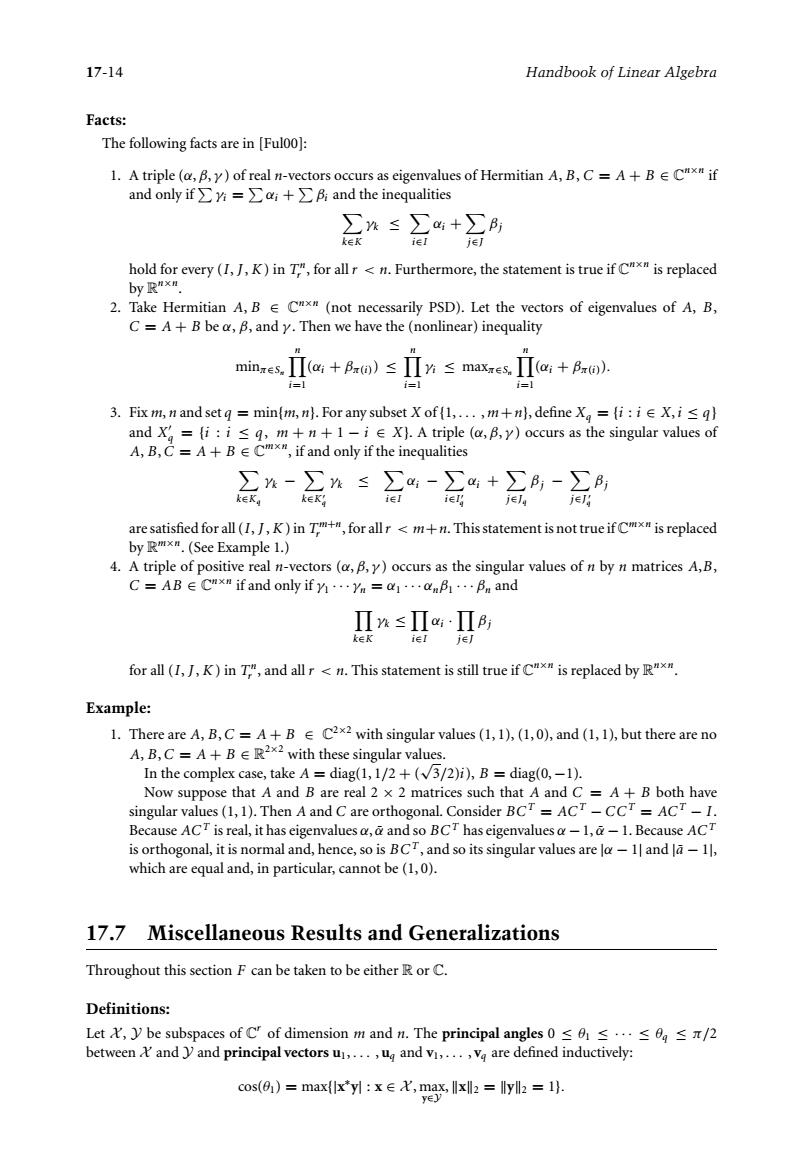正在加载图片...

17-14 Handbook of Linear Algebra Facts: The following facts are in [Ful0o]: Am≤于“+刷 hold for every(,K)infor allrn.Furthermore,the statement is true if is replaced by R 2.Take Hermitian.(not PSD).Let the vectors of ofA.B. C=A+B bea,B,andy.Then we have the (nonlinear)inequality minsesⅡa+Bao)sⅡn≤maxres.Ⅱa+Aal. 3.d ..m+), X)A triple (B)occurs as the singular valueso are satisfied for all (,K)in T,for allr<mn.This statement is not true ifCx is replaced by Rx".(See Example 1.) 4.A triple of positive real n-vectors (B,y)occurs as the singular values of n by n matrices A,B, C=AB∈if and only if…a=a…anBi…B.and n≤ⅡⅡ防 for all (1,K)in T",and allrn.This statement is still true if Cx is replaced byR Example: In the complex case,take A=diag(1,+()).B=diag(0.-1). Now s pose that A and B are real 2 x 2 matrices such that A and C=A+B both have singular values (1,1).Then A and C are orthogonal.Consider BCT=ACT-CCT=ACT-I. Because ACT is real,it has eigenvaluesa,and so BCT has eigenvaluesa-,-1.Because ACT is orthogonal,it is normal and,hence,so is BCT,and so its singular values are lo-1l and la-1l. which are equal and,in particular,cannot be(1,0). 17.7 Miscellaneous Results and Generalizations Throughout this section F can be taken to be eitherRorC. Definitions: LctX,ybe subspaces of C of dimension m and m.The principal angles0≤a≤…≤Ag≤x/2 betweenand y and principal vectorsu.,uandvi,...v are defined inductively: cos(0)=max'yl :y:=1).17-14 Handbook of Linear Algebra Facts: The following facts are in [Ful00]: 1. A triple (α, β, γ ) of real n-vectors occurs as eigenvalues of Hermitian A, B, C = A + B ∈ Cn×n if and only if γi = αi + βi and the inequalities k∈K γk ≤ i∈I αi + j∈J βj hold for every (I, J , K) in Tn r , for all r < n. Furthermore, the statement is true if Cn×n is replaced by Rn×n. 2. Take Hermitian A, B ∈ Cn×n (not necessarily PSD). Let the vectors of eigenvalues of A, B, C = A + B be α, β, and γ . Then we have the (nonlinear) inequality minπ∈Sn n i=1 (αi + βπ(i)) ≤ n i=1 γi ≤ maxπ∈Sn n i=1 (αi + βπ(i)). 3. Fix m, n and set q = min{m, n}. For any subset X of{1, ... , m+n}, define Xq = {i : i ∈ X, i ≤ q} and X q = {i : i ≤ q, m + n + 1 − i ∈ X}. A triple (α, β, γ ) occurs as the singular values of A, B,C = A + B ∈ Cm×n, if and only if the inequalities k∈Kq γk − k∈K q γk ≤ i∈I αi − i∈I q αi + j∈J q βj − j∈J q βj are satisfied for all (I, J , K) in Tm+n r , for allr < m+n. This statement is not true if Cm×n is replaced by Rm×n. (See Example 1.) 4. A triple of positive real n-vectors (α, β, γ ) occurs as the singular values of n by n matrices A,B, C = AB ∈ Cn×n if and only if γ1 ··· γn = α1 ··· αnβ1 ··· βn and k∈K γk ≤ i∈I αi · j∈J βj for all (I, J , K) in Tn r , and all r < n. This statement is still true if Cn×n is replaced by Rn×n. Example: 1. There are A, B,C = A + B ∈ C2×2 with singular values (1, 1), (1, 0), and (1, 1), but there are no A, B,C = A + B ∈ R2×2 with these singular values. In the complex case, take A = diag(1, 1/2 + ( √3/2)i), B = diag(0, −1). Now suppose that A and B are real 2 × 2 matrices such that A and C = A + B both have singular values (1, 1). Then A and C are orthogonal. Consider BCT = ACT − CCT = ACT − I. Because ACT is real, it has eigenvalues α, α¯ and so BCT has eigenvalues α −1, α¯ −1. Because ACT is orthogonal, it is normal and, hence, so is BCT , and so its singular values are |α − 1| and |a¯ − 1|, which are equal and, in particular, cannot be (1, 0). 17.7 Miscellaneous Results and Generalizations Throughout this section F can be taken to be either R or C. Definitions: Let X , Y be subspaces of Cr of dimension m and n. The principal angles 0 ≤ θ1 ≤ ··· ≤ θq ≤ π/2 between X and Y and principal vectors u1, ... , uq and v1, ... , vq are defined inductively: cos(θ1) = max{|x∗y| : x ∈ X , max y∈Y , x2 = y2 = 1}.���������